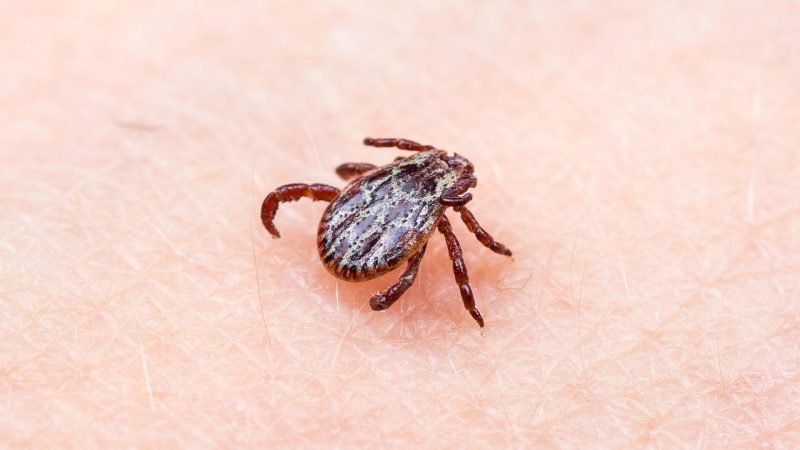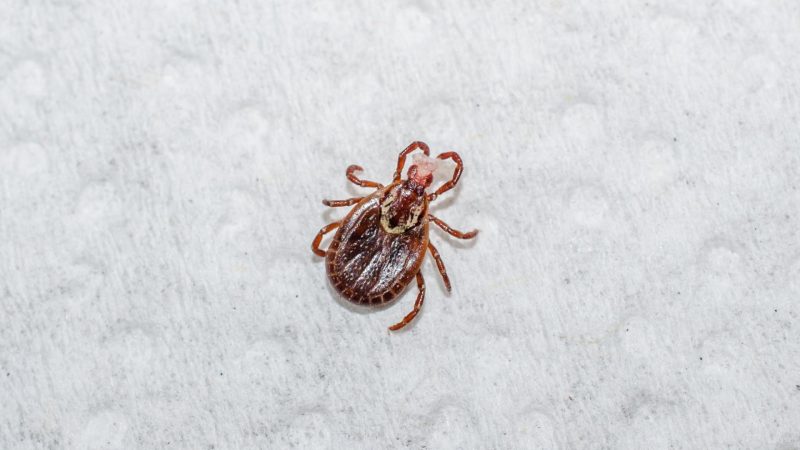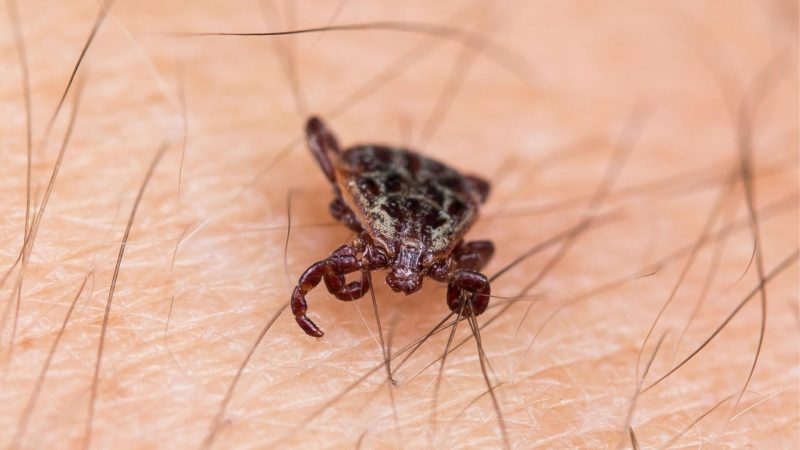Spring is the ideal season to have fun outside walking your dog. However, it is also the peak season for ticks, including wood ticks. This is the time when tick nymphs usually join the adult ones. These parasitic organisms attack mammals and humans, as well. This is why you must be very careful if you’re in the woods.
Are wood ticks dangerous? Wood ticks are dangerous because they can transmit highly infectious diseases to humans. This includes Tularemia and Rocky Mountain Spotted Fever (RMSF). Tick bites can also cause canine tick paralysis, which can eventually kill infected dogs if not treated immediately.
There are around 900 tick species spread around the world, and roughly 90 of these species are in the US. Wood ticks are among the most common species found in the Eastern part of the Rocky Mountains and some limited portions of the Pacific Coast. Nonetheless, they prefer to live in warm, humid environments. Continue reading to learn more about them.
What Are Wood Ticks?

Ticks are not insects. Instead, they are small arachnids, just like scorpions and spiders. There are two types of ticks – soft ticks and hard ticks. Wood sticks are hard ticks that mostly attack dogs. Hence, they are also called American dog ticks. However, they also bite bigger mammals, such as cattle and horses.
Scientifically known as Dermacentor variabilis, wood sticks undergo incomplete metamorphosis. They have four life cycle stages – egg, larva, nymph, and adult. However, nymphs are also called ticks. Tick larvae have 6 legs, while nymphs have 8 legs. In general, it can take 3 years for ticks to complete their full life cycle.
Wood sticks are usually tan and brown and are about 1/8 inches (approx. 3.18 mm.) long. They have an oval, flat body with some coloration. Male wood ticks have mottled gray patterns, while females have silver or white patterns. Female ticks also become bloated after feeding, while the males don’t get any bigger.
What Do Wood Ticks Eat?
Wood sticks are parasites, and they suck blood before they can move to the next stage of their life cycle. Once tick eggs are hatched, larvae should find a host and suck blood to become nymphs. As nymphs, they should find another host so they can suck blood to become adults. In short, wood ticks undergo a 3-host life cycle.
Where Do Wood Ticks Live?
Ticks like humid places with abundant vegetation. On the plus side, they don’t generally infest buildings!
Pets and animals may draw wood ticks; ticks will go toward regions where they can find hosts. Additionally, it’s conceivable that wood ticks adhere to animal scents. Ticks are frequently seen perched on grass, shrubs, and other low- to mid-length plants where they can quickly hop onto neighboring hosts.
What Is the Lifespan of a Wood Tick?
A wood tick has an average lifespan of about 2-3 years, depending on how long it can find a host. Mating usually happens on the host, and male ticks will soon die after mating. Meanwhile, female wood sticks would then drop to the ground to reproduce. After six to thirteen days, they will lay about 4,000 eggs and will die.
How Long Do Wood Ticks Live Without a Host?
Interestingly, wood tick larvae can survive up to 11 months without a blood meal. Their nymphs can survive about 6 months without feeding. Once they become adults, they can still survive for around 2 years without a host. However, some tick species cannot survive that long, especially when they are always indoors.
Do Wood Ticks Jump?
Wood ticks don’t jump. In fact, they also don’t fly because they have no wings. Therefore, they find a source of food by using a method called “questing.” Here, wood ticks patiently wait for hosts to pass by. Aside from dogs, cattle, and horses, adult wood ticks also feed on deer, opossums, raccoons, and humans.
Instead of jumping, wood ticks climb to a host that brushes against them. Adult ticks climb the fastest on humans and large animals. On the other hand, tick larvae and nymphs climb slowly on smaller hosts. In general, ticks prefer to bite on thinner skins. Once they are full, they will simply drop their bodies to the ground.
Lifecycle of the Wood Tick
A kind of tick known has four unique lifecycle stages: eggs, larvae, nymphs, and adults.
For them to thrive after emerging from their egg, a tick must consume blood from a host at each phase of its existence. The term larva refers to the newly hatched tick. Tick larvae are only six-legged and measure around 1/8 of an inch.
Tick larvae cannot jump, so they must hang on plants or remain on leaves until a warm-blooded creature passes by and then cling on. It appears as though the tick is attempting to stand up and seize the sky when it engages in questing. The larva will descend to the ground and molt into an eight-legged nymph after finishing its initial host’s meal.
When a second warm-blooded host, such as a raccoon, possum, or other large mammal, passes near, nymphs wait patiently for it. Following that, the nymph will eat continuously for a few days until it swells with blood. In order to become an adult tick, it once more falls to the earth.
In search of their third and final host, adult ticks will target large animals like deer or dogs, where they can eat, reproduce, leave droppings, and lay eggs. After producing a few thousand eggs, the female passes away.
What Purpose Do Wood Ticks Serve?

Wood ticks are notorious pests, but it does not mean they have no purpose. They are the favorite source of food for chickens, turkeys, birds, reptiles, guinea pigs, opossums, and amphibians. Therefore, their population helps scientists monitor the status of our ecosystem. Ticks also provide the diversity of life.
Are Ticks Only Found in Wooded Areas?

Ticks are found not only in wooden areas. Although these blood-sucking pests usually live in the woods, you can also find them in animals, especially dogs. As mentioned earlier, ticks attached themselves to their host to suck blood. After feeding, they will leave and will grow to the next stage of their life cycle.
However, ticks can also be found in cat and dog shelters, veterinary clinics or offices, or even outdoors such as parks and in the streets. These creepy bloodsuckers may also be inside your home without your knowledge. This is because infected animals (especially dogs) may carry them everywhere they go.
Where Are Ticks Found at Home?
Generally speaking, wood ticks don’t usually populate indoors. However, they can enter your house if your infested dog accidentally brings them in. On the other hand, other tick species, such as brown dog ticks prefer laying eggs indoors. This is why it’s very likely that you may also find ticks inside your home.
Believe it or not, a single tick that was brought inside your house by your pet dog can later cause a severe tick infestation. This is because ticks reproduce very quickly and can lay their eggs in different parts of your home. This includes furniture, curtains, carpets, crevices, cracks, and behind the windows and doors.
Are Wood Ticks Harmful?

Wood ticks are harmful, especially since they carry some pathogens and bacteria that can potentially cause serious tickborne diseases. They embed their mouthparts in the skin of their innocent hosts for several hours before they finish a blood meal. Therefore, wood ticks have lots of time to become disease vectors.
Also, contrary to some beliefs, ticks don’t have to be infected with tularemia to transmit it to another host. It can also be transmitted by handling infected dead animals and contaminated items, drinking contaminated water, and being bitten by an infected animal such as mice. This is also why wood ticks are harmful.
Do Wood Ticks Carry Lyme Disease?
Wood ticks are not known for carrying Lyme disease, scientifically known as Borrelia burgdorferi. The two tick species that carry this infectious disease are the black-legged tick (Ixodes scapularis) in the Northeastern and Upper Midwestern US regions and the Western black-legged tick (Ixodes pacificus) in the Pacific Coast.
Do Wood Ticks Bite Humans?
Wood ticks also bite humans. However, their bites are not usually painful and can only cause minor swelling, itching, and redness on your skin. However, people who are allergic to tick bites might have a different reaction. Likewise, dogs are not irritated with tick bites, which means it can be hard to detect them.
What to Do if a Wood Tick Bites You?
Wood tick bites are not painful. In fact, you can remove a tick while it is biting you. However, there is a proper way to do it. If you make a mistake, the chance of getting a disease will be higher, or the wound will take longer to heal. Below are the steps on how to safely remove a biting tick from your skin.
Step 1: Use a pair of fine-tipped tweezers or curved forceps to grasp the tick. Never use bare hands. Otherwise, bacteria may enter your body.
Step 2: Pull the tick straight upward carefully and steadily and with consistent pressure. Be very careful not to twist or squeeze the tick. Otherwise, the tick will break, causing its mouthparts to remain intact on your skin.
Step 3: Once the tick is removed, wash your wound with soap and water. You may also use rubbing alcohol to disinfect your skin.
Step 4: Tick disposal should be done properly. Place it in a container with alcohol or throw it in the toilet bowl and flush it.
Alternatively, you can keep the tick in a plastic container for about 2 weeks. Record the date you remove it and the part of your body where the tick bit you. You may need to examine it later if you have some symptoms of illness due to tick bites.
Observe your health for the next few days. Among the early symptoms of tick-borne disease are muscle pain, fever, headache, nausea, and diarrhea.
What Not to Do if a Wood Tick Bites You (Or Your Dog)?
Don’t burn the tick while it is biting you. Also, don’t suffocate the tick using nail polish, petroleum jelly, rubbing alcohol, or gasoline. If you will do these techniques, your skin (or your dog’s skin) may suffer from burns. Also, the tick may release fluid which will increase your chance of getting infected.
How to Remove a Wood Tick From Your Dog?
The steps for removing ticks from your dog are similar to the steps for removing a tick from your skin. However, your dog mostly has lots of ticks, and not only one. Therefore, you should not focus on one area only. Instead, slowly run your fingers on your dog’s body, face, under its toes, and inside its ears.
If your dog has lots of furs, you may not easily see the ticks. Nevertheless, a bump or a swollen area can be a sign of the presence of ticks or a tick bit that part. Aside from tweezers, you can also use a dog tick remover. This tool is more effective than tweezers and is easier to use because it is designed for hair-dense areas.
How to Get Rid of Wood Ticks?
To get rid of wood ticks, you can do the following:
- Inspect your dogs regularly and thoroughly, especially if they are outdoors most of the time and when bathing them.
- Treat your pets with insect repellents or insecticides. Most mosquito and flea repellents work well against ticks. However, make sure they are safe for you and your dog.
- Wash or dry clean all pet bedding. If infestation is severe, replace them with new ones.
- Vacuum all carpets, floors, and areas where your dog usually rests or sleeps.
- Cut the grass and weeds short. This reduces the chance of ticks climbing to their host.
- Remove or burn leaf litter, dead leaves, and other plant debris.
- Seal the cracks and crevices around and inside the property.
How to Prevent Wood Ticks?
To prevent wood ticks from infesting your property, you can do the following:
- Have a regular check on possible cracks on your walls, windows, and doors.
- If you are in or around wooded areas, stay away from brush and high grass.
- Don’t place your lawn equipment and furniture near wooded, shady areas. Sunlight is the tick’s worst enemy.
- While working in your yard, wear long sleeves and gloves. Tuck your pants inside your boots or socks. It will serve as a barrier against ticks.
- Wear light-colored clothes. If a tick crawls on you, you can easily spot them.
- Reduce wildlife activity around or close to your property. Deer and raccoons may also carry ticks.
- Maintain short grass and weeds in your yard.
- If possible, keep your pet dogs indoors. Clean kennels regularly.
- Place tick tubes in your yard, especially during the spring season. They work well in areas where sprays cannot reach.
Related: How To Get Rid of Ticks in Yard | A Complete Guide
List of Sources
Chan. W., Kaufman, P. E. (2021). American Dog Tick, Dermacentor variabilis (Say) (Arachnida: Ixodida: Ixodidae). University of Florida.
Tick Biology and Ecology. University of Maine.
Houseman, R. M. (2013). Ticks and Tick-borne Diseases. University of Missouri.
Diseases Transmitted by Ticks. (2020). Centers for Disease Control and Prevention.
- Bed Bug Surge 2025: How to Detect, Prevent, and Safely Eliminate Infestations in Top U.S. Cities - June 18, 2025
- Asian Needle Ants Invade US Homes: 2025 Guide to Identification, Risks, and Effective Control - June 11, 2025
- New World Screwworm Alert: How US Livestock Owners Can Prevent Outbreaks and Protect Herds [Summer 2025 Update] - June 8, 2025
